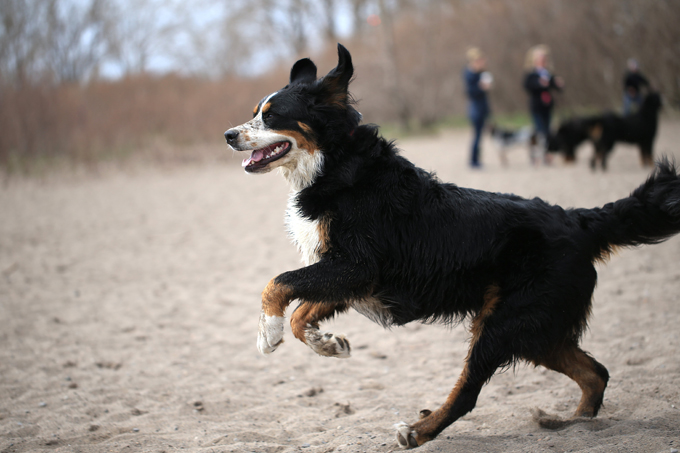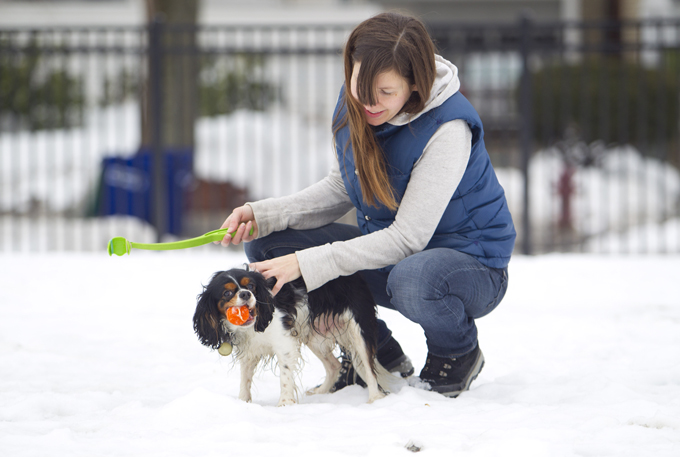Veterinarians are fixing broken hearts. Just ask Daisy’s owner. Almost three years ago, the once-spry King Charles Cavalier Spaniel began slowing down. Her owner’s went through all the normal excuses: she was getting older; it was her joints; it was too hot, cold or humid. The cover-ups continued until Daisy’s owners realized their precious pooch was struggling to catch her breath on slow walks around the neighborhood. Something serious was going on. Something had to be done.
As Daisy was examined by her veterinarian, the odds weren’t in her favor. Studies show that up to six out of ten Cavalier King Charles Spaniels over the age of four have a form of heart failure known as mitral valve disease (MVD). Ten years ago, this meant several months of worsening quality of life before succumbing to the untimely end. But not today, not for Daisy.
Today’s veterinarians are armed with better diagnostic tests and treatments for heart disease than ever before. Daisy’s veterinarian identified her problem and promptly referred her to the Veterinary Teaching Hospital at the University of Pennsylvania where veterinary cardiologists performed echocardiography (ultrasound evaluation of the heart) and prescribed a combination of drugs that literally brought her back to living.
That was almost three years ago. Daisy’s family still gives her daily medications, including pimobendan, a life-sparing heart medication used in humans in Japan, and keeps up with frequent visits to her regular vet. If you didn’t know it, you’d swear she was half her age without the slightest problem. One broken heart fixed. One family grateful for the return of their fun-loving, four-legged family member.
Heart disease can strike any dog or cat at any age. Many forms of heart disease are inherited and appear when the pet is young while others are associated with advancing age. The best way to prevent heart failure is to provide a healthy, active lifestyle for your pet and have your pet examined yearly and twice a year for pets over seven. Daily walks, avoiding high-fat foods and high-calorie treats and maintaining a healthy weight are essential to keeping your pet’s heart healthy. If heart disease is diagnosed early, your pet may be able to avoid the consequences of heart failure such as shortness of breath, coughing, sudden collapse, depression and loss of stamina.
Unfortunately, not everyone notices a problem until almost too late.

As long as I’d been seeing Dutchess, she had always been a little overweight. Because she was a Dachshund, this placed her at great danger for back problems. The furthest thing from her owner’s mind was heart failure.
When Dutchess went in for her annual visit, her owner was quick to point out the new, svelte Dutchess. It was true; Dutchess had lost over four pounds. Had the owner changed food? Increased exercise? I wanted to know the secret to Dutchess’ weight loss.
Nothing had changed. Lately she just wasn’t that interested in food. Plus, she hardly got any exercise because she coughed so much when she was walked. Her owner guessed the coughing was just her allergies acting up. Dutchess’ owner didn’t know what it was and she was surprised I wasn’t happy about the weight loss.
Turns out it wasn’t an allergy and she wasn’t tired of her dog food. It was her heart. Dutchess was experiencing advanced mitral valve disease, just like Daisy the Cavalier King Charles Spaniel. While Dutchess wasn’t likely born with a defective heart, bad genes combined with worse lifestyle had resulted in failure of one of her heart’s major valves, the mitral valve. Less blood was exiting her heart and more was backing up in her lungs. No wonder she didn’t want to eat or walk. She was literally drowning in her own fluids and barely had enough oxygen to walk more than a few yards. Dutchess was in serious trouble.
When I started practicing veterinary medicine almost twenty years ago, patients like Dutchess had few options. In fact, there were only a handful of drugs to choose from, many with nasty side-effects. Dogs in the later stages of heart failure were usually given a grave prognosis and an expected early demise. Good thing Dutchess and I didn’t meet years ago. Today was a whole new ballgame and we had a great chance of winning.
Dutchess was placed on heart medications benazapril, furosemide and pimobendan and a sodium-restricted diet. Within days her owner was calling to tell us that Dutchess had returned to her old tricks, including counter-surfing for goodies. The old Dutchess was back! Another broken heart fixed and another pet parent appreciative for a new lease on their pet’s life.
Heart disease doesn’t only affect dogs; cats get their fair share. Sadly, heart disease in cats is usually not diagnosed until late in the disease and is typically more serious than in dogs. The Dolan family found this out the hard way. Their cat, Harry, is the first feline survivor of open-heart surgery.
There are two ways to fix a broken heart. The first, and by far most common, is to use drugs to manipulate the cardiovascular system into functioning more normally. The problem persists but the patient is able to resume a more normal lifestyle. The second, and rarely pursued, treatment is surgery. Open it up and fix that sucker!
There are many reasons heart surgery isn’t routinely performed in pets the way it is in humans. The first is simply the size of the heart. Dogs and cats are much smaller than humans and the instruments and techniques haven’t been scaled-down and perfected in veterinary patients. These technical issues will be solved.
The second reason open-heart surgery isn’t commonly performed is cost. Heart surgery is expensive. It’s not uncommon for many open-heart surgeries to cost $75,000 to $100,000 in people. Even if veterinarians were able to perform the surgeries for one-tenth to one-fifth the cost of human heart surgery, that still equals about $10,000 to $20,000. For many pet owners, despite their love for their pet, the cost is simply too much. Pet insurance saved Harry Dolan.
When the Dolan’s brought Harry, a purebred Maine Coon cat, home, they purchased a pet insurance policy from PetPlan. They thought it would be a good idea but never imagined how much that simple purchase would change their lives – and Harry’s.
When Harry was diagnosed with heart disease as a kitten, the Dolans were devastated. They had fallen head-over-heels in love with their new purr-bucket. Harry was given a twelve to eighteen months to live. Surely something could be done.
Harry was brought to a cardiologist and a team of veterinarians agreed to try the impossible – fix Harry’s heart surgically. After many tests and consultations, the veterinarians devised a surgical approach to correct Harry’s cardiomyopathy. The surgery would carry considerable risk, but the potential benefit would be years of normal life. The Dolans agreed to the surgery.
But before they could proceed with the surgery, the Dolans needed to know how much it would cost. The Dolans were a middle-class family and money was tight. The team of experts added up the costs. The final bill could easily exceed $20,000. And that’s when the Dolans were thankful for PetPlan.
Because the Dolans had chosen to provide pet insurance for Harry, how they would pay for his care wasn’t part of their decision. The family could focus on what mattered most – getting Harry the best possible care – and not be forced to make difficult decisions based on their ability to pay. Quite literally, pet insurance saved Harry’s life.
Certain breeds have a higher incidence of heart problems. The most common inherited heart defect is a patent ductus arteriosus (PDA). This is a condition in which a “hole” in the heart fails to close after birth, resulting in a life-threatening form of heart failure. Breeds commonly affected are Maltese, Toy and Miniature Poodle, and Shetland Sheepdog. Other congenital heart defects include subvalvular aortic stenosis (SAS) which is more common in large breed dogs including Newfoundlands, Golden Retrievers, Boxers and Rottweilers and pulmonic valve stenosis (PS) seen most commonly in smaller breed dogs including Beagles, Fox Terriers, Miniature Schnauzers and West Highland White Terriers.
Heart disease is also common in breeds including Cavalier King Charles Spaniels, Boxers, Doberman Pinschers, Irish Wolfhounds, Great Danes, Scottish Deerhounds and Newfoundland dogs. Cat breeds associated with inherited heart disease are Maine Coon, Ragdoll, Rex, American and British shorthair.
How can you tell if your pet has heart disease? The best way is to have your pet frequently examined by your veterinarian. At least once a year pets under age seven should have their hearts carefully listened to by your vet. Older pets have a much higher incidence of heart disease. Pets over age seven should be checked out every six months and tests such as chest x-rays, blood pressure and electrocardiogram (ECG) performed every year or two. Breeds prone to cardiomyopathy (an abnormal enlargement of the heart) such as Doberman pinschers, Boxers and Maine Coon cats or congenital heart disease in breeds that include Cavalier King Charles Spaniels should undergo additional heart tests such as ECG or echocardiography every six to twelve months once they’re three to five years of age.
Common symptoms of heart disease in dogs and cats include coughing, decreased stamina, pale gums or skin, lethargy, decreased appetite, swollen abdomen and decreased play or interactivity. Of course, any pet can have an off day, but if these symptoms persist for more than a couple of days, take them to your vet immediately.
Our furry friends freely and unconditionally give us their hearts. The least we can do is help mend it when it needs fixing.









